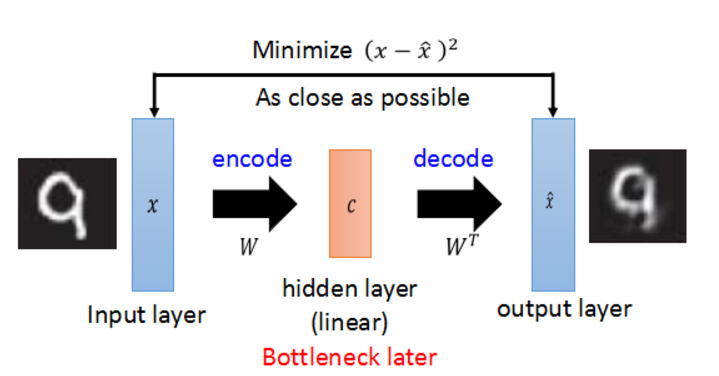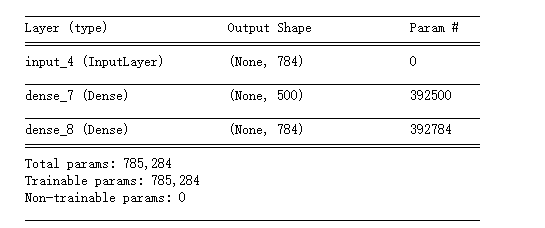Keras實現autoencoder
阿新 • • 發佈:2018-11-19
Keras實現autoencoder
Keras使我們搭建神經網路變得異常簡單,之前我們使用了Sequential來搭建LSTM:keras實現LSTM。
我們要使用Keras的functional API搭建更加靈活的網路結構,比如說本文的autoencoder,關於autoencoder的介紹可以在這裡找到:deep autoencoder。
現在我們就開始。
step 0 匯入需要的包
1 import keras 2 from keras.layers import Dense, Input 3 from keras.datasets import mnist 4 from keras.models import Model 5 import numpy as np
step 1 資料預處理
這裡需要說明一下,匯入的原始資料shape為(60000,28,28),autoencoder使用(60000,28*28),而且autoencoder屬於無監督學習,所以只需要匯入x_train和x_test.
1 (x_train, _), (x_test, _) = mnist.load_data()
2 x_train = x_train.astype('float32')/255.0
3 x_test = x_test.astype('float32')/255.0
4 #print(x_train.shape)
5 x_train = x_train.reshape(x_train.shape[0], -1)
6 x_test = x_test.reshape(x_test.shape[0], -1)
7 #print(x_train.shape)step 2 向圖片新增噪聲
新增噪聲是為了讓autoencoder更robust,不容易出現過擬合。
1 #add random noise 2 x_train_nosiy = x_train + 0.3 * np.random.normal(loc=0., scale=1., size=x_train.shape) 3 x_test_nosiy = x_test + 0.3 * np.random.normal(loc=0, scale=1, size=x_test.shape) 4 x_train_nosiy = np.clip(x_train_nosiy, 0., 1.) 5 x_test_nosiy = np.clip(x_test_nosiy, 0, 1.) 6 print(x_train_nosiy.shape, x_test_nosiy.shape)
step 3 搭建網路結構
分別構建encoded和decoded,然後將它們連結起來構成整個autoencoder。使用Model建模。
1 #build autoencoder model 2 input_img = Input(shape=(28*28,)) 3 encoded = Dense(500, activation='relu')(input_img) 4 decoded = Dense(784, activation='sigmoid')(encoded) 5 6 autoencoder = Model(input=input_img, output=decoded)
step 4 compile
因為這裡是讓解壓後的圖片和原圖片做比較, loss使用的是binary_crossentropy。
1 autoencoder.compile(optimizer='adam', loss='binary_crossentropy') 2 autoencoder.summary()

step 5 train
指定epochs,batch_size,可以使用validation_data,keras訓練的時候不會使用它,而是用來做模型評價。
autoencoder.fit(x_train_nosiy, x_train, epochs=20, batch_size=128, verbose=1, validation_data=(x_test, x_test))
step 6 對比一下解壓縮後的圖片和原圖片
1 %matplotlib inline 2 import matplotlib.pyplot as plt 3 4 #decoded test images 5 decoded_img = autoencoder.predict(x_test_nosiy) 6 7 n = 10 8 plt.figure(figsize=(20, 4)) 9 for i in range(n): 10 #noisy data 11 ax = plt.subplot(3, n, i+1) 12 plt.imshow(x_test_nosiy[i].reshape(28, 28)) 13 plt.gray() 14 ax.get_xaxis().set_visible(False) 15 ax.get_yaxis().set_visible(False) 16 #predict 17 ax = plt.subplot(3, n, i+1+n) 18 plt.imshow(decoded_img[i].reshape(28, 28)) 19 plt.gray() 20 ax.get_yaxis().set_visible(False) 21 ax.get_xaxis().set_visible(False) 22 #original 23 ax = plt.subplot(3, n, i+1+2*n) 24 plt.imshow(x_test[i].reshape(28, 28)) 25 plt.gray() 26 ax.get_yaxis().set_visible(False) 27 ax.get_xaxis().set_visible(False) 28 plt.show()
這樣的結果,你能分出哪個是壓縮解壓縮後的圖片哪個是原圖片嗎?

reference:

